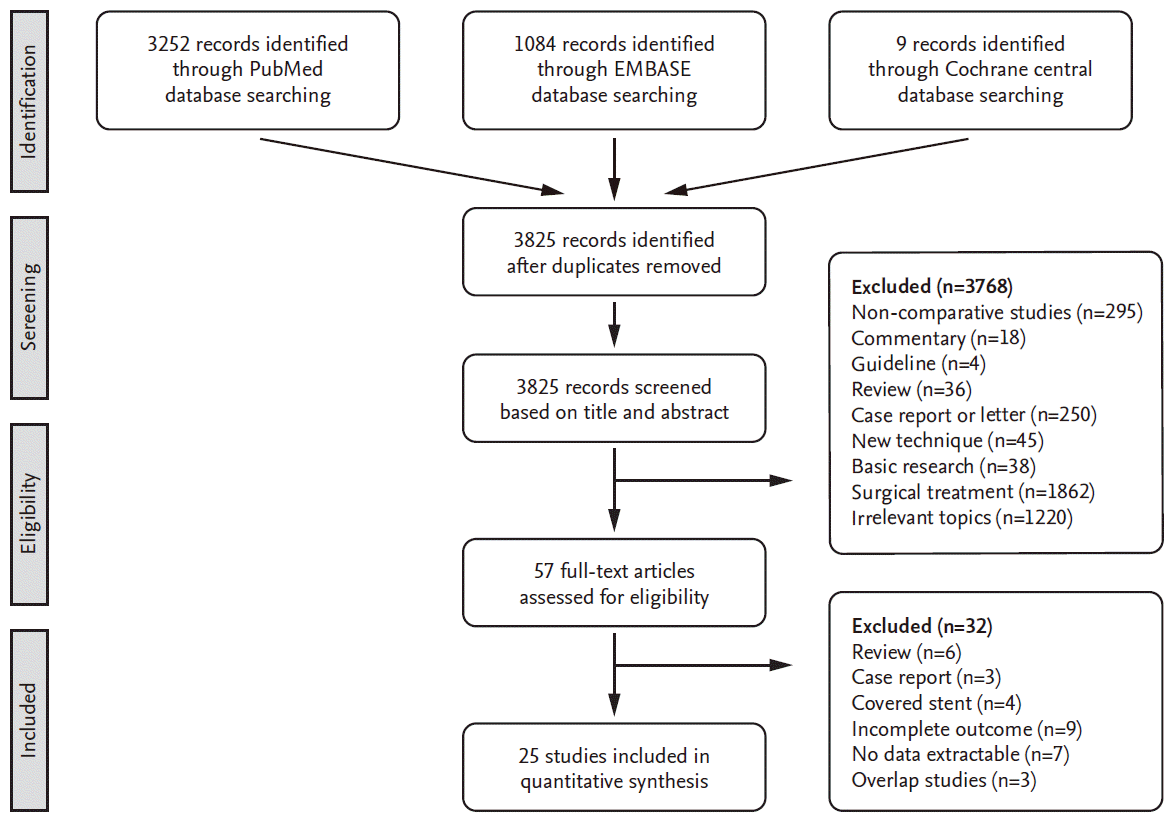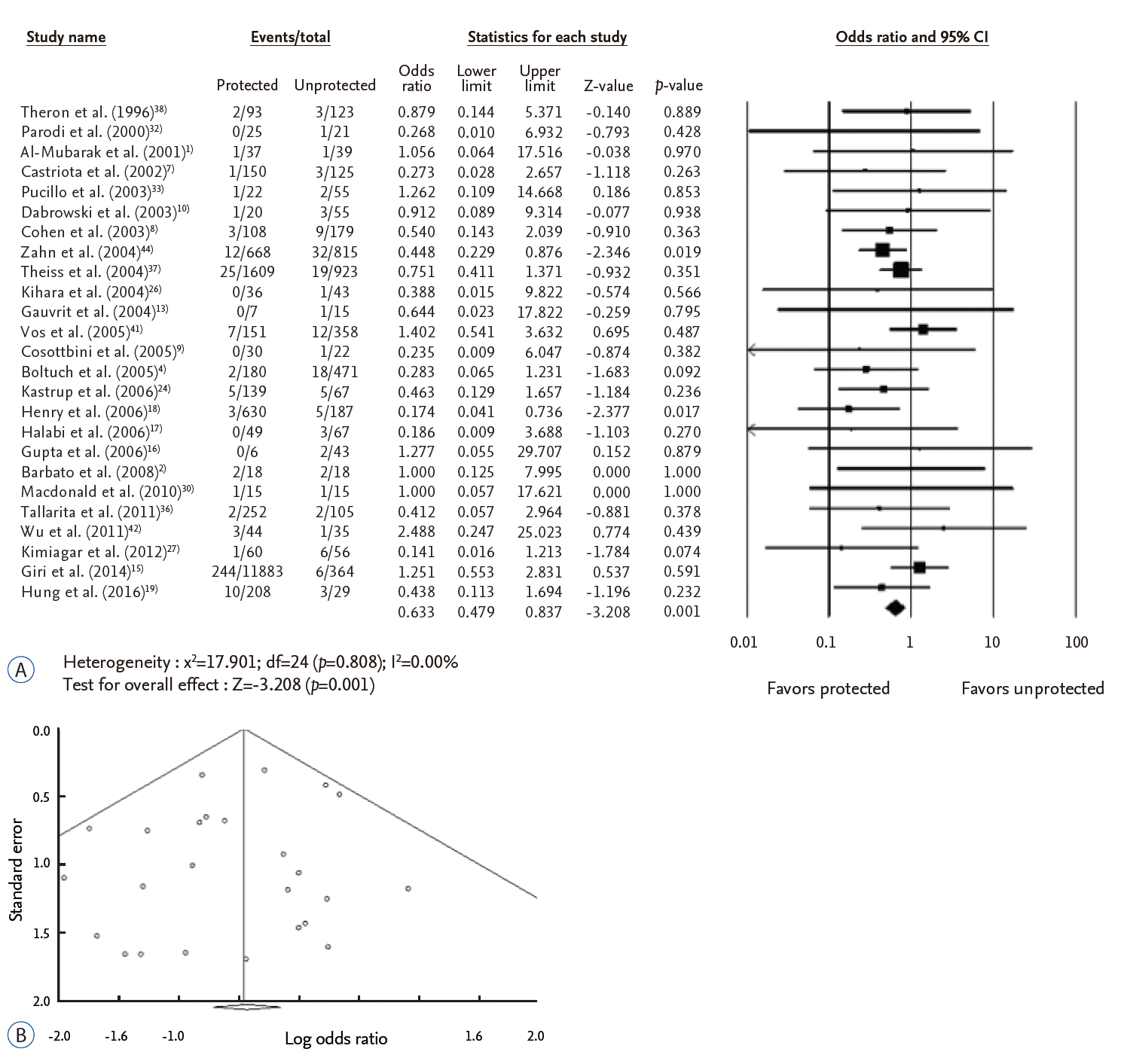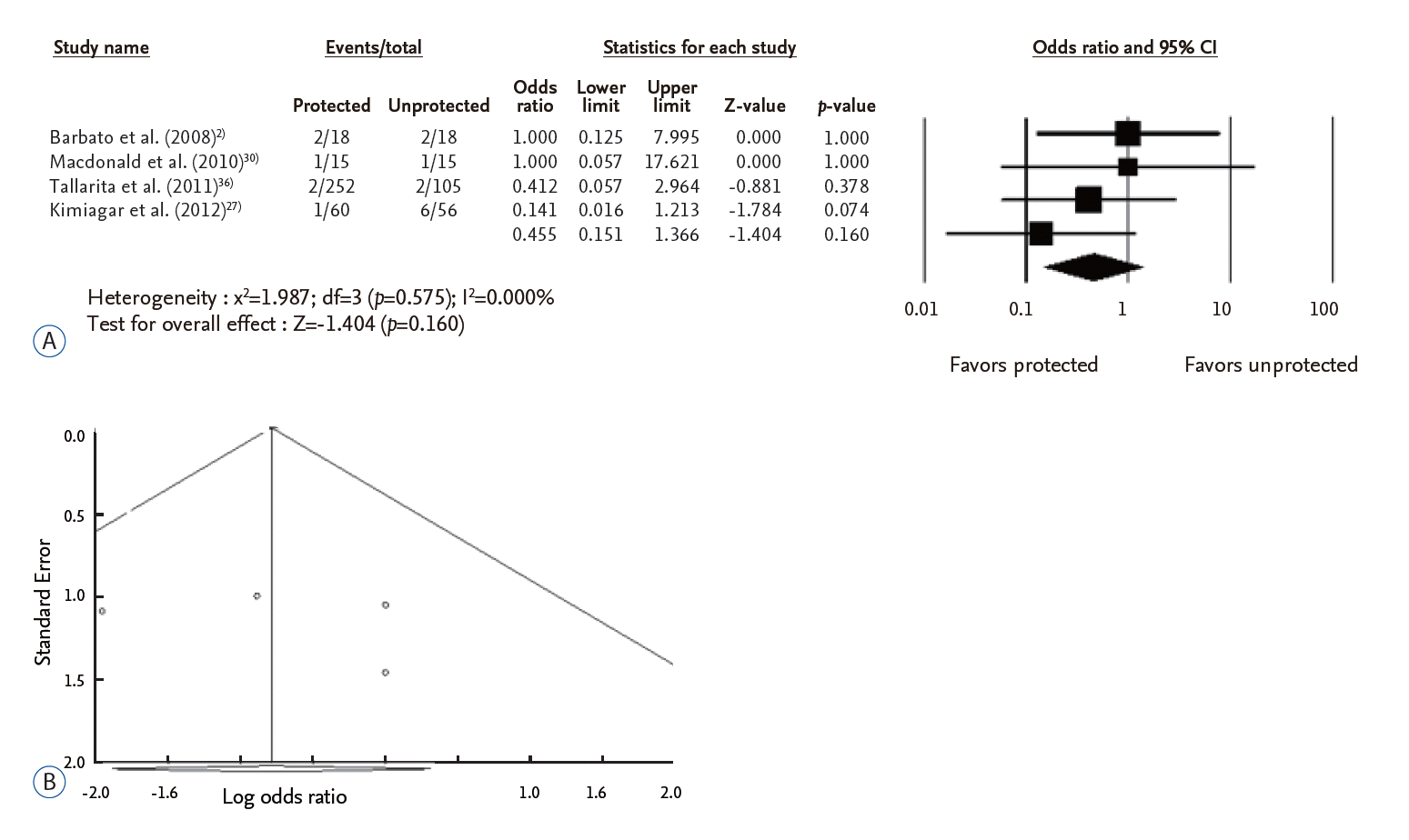1. Al-Mubarak N, Roubin GS, Vitek JJ, Iyer SS, New G, Leon MB. Effect of the distal-balloon protection system on microembolization during carotid stenting. Circulation. 104:1999–2002. 2001.

2. Barbato JE, Dillavou E, Horowitz MB, Jovin TG, Kanal E, David S, et al. A randomized trial of carotid artery stenting with and without cerebral protection. J Vasc Surg. 47:760–765. 2008.

3. Begg CB, Mazumdar M. Operating characteristics of a rank correlation test for publication bias. Biometrics. 50:1088–1101. 1994.

4. Boltuch J, Sabeti S, Amighi J, Dick P, Mlekusch W, Schlager O, et al. Procedure-related complications and early neurological adverse events of unprotected and protected carotid stenting: temporal trends in a consecutive patient series. J Endovasc Ther. 12:538–547. 2005.

5. Bonati LH, Lyrer P, Ederle J, Featherstone R, Brown MM. Percutaneous transluminal balloon angioplasty and stenting for carotid artery stenosis. Cochrane Database Syst Rev. (9):CD000515. 2012.

6. Bosiers M, de Donato G, Deloose K, Verbist J, Peeters P, Castriota F, et al. Does free cell area influence the outcome in carotid artery stenting? Eur J Vasc Endovasc Surg. 33:135–141. discussion 142-133. 2007.

7. Castriota F, Cremonesi A, Manetti R, Liso A, Oshola K, Ricci E, et al. Impact of cerebral protection devices on early outcome of carotid stenting. J Endovasc Ther. 9:786–792. 2002.

8. Cohen JE, Lylyk P, Ferrario A, Gomori JM, Umansky F. Carotid stent angioplasty: the role of cerebral protection devices. Neurol Res. 25:162–168. 2003.

9. Cosottini M, Michelassi MC, Puglioli M, Lazzarotti G, Orlandi G, Marconi F, et al. Silent cerebral ischemia detected with diffusion-weighted imaging in patients treated with protected and unprotected carotid artery stenting. Stroke. 36:2389–2393. 2005.

10. Dabrowski M, Bielecki D, Gołebiewski P, Kwiecin’ski H. Percutaneous internal carotid artery angioplasty with stenting: early and long-term results. Kardiol Pol. 58:469–480. 2003.
11. Egger M, Davey Smith G, Schneider M, Minder C. Bias in meta-analysis detected by a simple, graphical test. BMJ. 315:629–634. 1997.

12. Garg N, Karagiorgos N, Pisimisis GT, Sohal DP, Longo GM, Johanning JM, et al. Cerebral protection devices reduce periprocedural strokes during carotid angioplasty and stenting: a systematic review of the current literature. J Endovasc Ther. 16:412–427. 2009.

13. Gauvrit JY, Delmaire C, Henon H, Debette S, al Koussa M, Leys D, et al. Diffusion/perfusion-weighted magnetic resonance imaging after carotid angioplasty and stenting. J Neurol. 251:1060–1067. 2004.

14. Giri J, Parikh SA, Kennedy KF, Weinberg I, Donaldson C, Hawkins BM, et al. Proximal versus distal embolic protection for carotid artery stenting: a national cardiovascular data registry analysis. JACC Cardiovasc Interv. 8:609–615. 2015.
15. Giri J, Yeh RW, Kennedy KF, Hawkins BM, Weinberg I, Weinberg MD, et al. Unprotected carotid artery stenting in modern practice. Catheter Cardiovasc Interv. 83:595–602. 2014.

16. Gupta AK, Purkayastha S, Kapilamoorthy TR, Nair MD, Krishnamoorthy T, Rupa S, et al. Carotid artery stenting: results and long-term follow-up. Neurol India. 54:68–72. 2006.

17. Halabi M, Gruberg L, Pitchersky S, Kouperberg E, Nikolsky E, Hoffman A, et al. Carotid artery stenting in surgical high-risk patients. Catheter Cardiovasc Interv. 67:513–518. 2006.

18. Henry M, Polydorou A, Henry I, Anagnostopoulou IS, Polydorou IA, Hugel M. Carotid angioplasty and stenting under protection. Techniques, results and limitations. J Cardiovasc Surg (Torino). 47:519–546. 2006.
19. Hung CS, Lin MS, Chen YH, Huang CC, Li HY, Kao HL. Prognostic factors for neurologic outcome in patients with carotid artery stenting. Acta Cardiol Sin. 32:205–214. 2016.
20. International Carotid Stenting Study investigators, Ederle J, Dobson J, Featherstone RL, Bonati LH, van der Worp HB, et al. Carotid artery stenting compared with endarterectomy in patients with symptomatic carotid stenosis (international carotid stenting study): an interim analysis of a randomised controlled trial. Lancet. 375:985–997. 2010.

21. Jeon JP, Kim JE. A recent update of clinical and research topics concerning adult moyamoya disease. J Korean Neurosurg Soc. 59:537–543. 2016.

22. Jeon JP, Kim JE, Cho WS, Bang JS, Son YJ, Oh CW. Meta-analysis of the surgical outcomes of symptomatic moyamoya disease in adults. J Neurosurg. 128:793–799. 2018.

23. Jeon JS, Sheen SH, Hwang G. Hemodynamic instability during carotid angioplasty and stenting-relationship of calcified plaque and its characteristics. Yonsei Med J. 54:295–300. 2013.

24. Kastrup A, Nägele T, Groschel K, Schmidt F, Vogler E, Schulz J, et al. Incidence of new brain lesions after carotid stenting with and without cerebral protection. Stroke. 37:2312–2316. 2006.

25. Kastrup A, Skalej M, Krapf H, Nägele T, Dichgans J, Schulz JB. Early outcome of carotid angioplasty and stenting versus carotid endarterectomy in a single academic center. Cerebrovasc Dis. 15:84–89. 2003.

26. Kihara EN, Andrioli MS, Zukerman E, Peres MF, Porto Júnior PP, Monzillo PH, et al. Endovascular treatment of carotid artery stenosis: retrospective study of 79 patients treated with stenting and angioplasty with and without cerebral protection devices. Arq Neuropsiquiatr. 62:1012–1015. 2004.

27. Kimiagar I, Gur AY, Auriel E, Peer A, Sacagiu T, Bass A. Long-term follow-up of patients after carotid stenting with or without distal protective device in a single tertiary medical center. Vasc Endovascular Surg. 46:536–541. 2012.

28. Kosowski M, Zimoch W, Gwizdek T, Konieczny R, Kübler P, Telichowski A, et al. Safety and efficacy assessment of carotid artery stenting in a high-risk population in a single-centre registry. Postepy Kardiol Interwencyjnej. 10:258–263. 2014.
29. Kouvelos GN, Patelis N, Antoniou GA, Lazaris A, Matsagkas MI. Meta-analysis of the effect of stent design on 30-day outcome after carotid artery stenting. J Endovasc Ther. 22:789–797. 2015.

30. Macdonald S, Evans DH, Griffiths PD, McKevitt FM, Venables GS, Cleveland TJ, et al. Filter-protected versus unprotected carotid artery stenting: a randomised trial. Cerebrovasc Dis. 29:282–289. 2010.

31. Mas JL, Chatellier G, Beyssen B, Branchereau A, Moulin T, Becquemin JP, et al. Endarterectomy versus stenting in patients with symptomatic severe carotid stenosis. N Engl J Med. 355:1660–1671. 2006.

32. Parodi JC, La Mura R, Ferreira LM, Mendez MV, Cersósimo H, Schönholz C, et al. Initial evaluation of carotid angioplasty and stenting with three different cerebral protection devices. J Vasc Surg. 32:1127–1136. 2000.

33. Pucillo AL, Mateo RB, Aronow WS. Effect of carotid angioplasty-stenting on short-term mortality and stroke. Heart Dis. 5:378–379. 2003.

34. Rhim JK, Jeon JP, Park JJ, Choi HJ, Cho YD, Sheen SH, et al. Prediction of prolonged hemodynamic instability during carotid angioplasty and stenting. Neurointervention. 11:120–126. 2016.

35. SPACE Collaborative Group, Ringleb PA, Allenberg J, Brückmann H, Eckstein HH, Fraedrich G, et al. 30 day results from the SPACE trial of stent-protected angioplasty versus carotid endarterectomy in symptomatic patients: a randomised non-inferiority trial. Lancet. 368:1239–1247. 2006.

36. Tallarita T, Rabinstein AA, Cloft H, Kallmes D, Oderich GS, Brown RD, et al. Are distal protection devices 'protective' during carotid angioplasty and stenting? Stroke. 42:1962–1966. 2011.

37. Theiss W, Hermanek P, Mathias K, Ahmadi R, Heuser L, Hoffmann FJ, et al. Pro-CAS: a prospective registry of carotid angioplasty and stenting. Stroke. 35:2134–2139. 2004.
38. Theron JG, Payelle GG, Coskun O, Huet HF, Guimaraens L. Carotid artery stenosis: treatment with protected balloon angioplasty and stent placement. Radiology. 201:627–636. 1996.

39. Topakian R, Strasak AM, Sonnberger M, Haring HP, Nussbaumer K, Trenkler J, et al. Timing of stenting of symptomatic carotid stenosis is predictive of 30-day outcome. Eur J Neurol. 14:672–678. 2007.

40. Touzé E, Trinquart L, Chatellier G, Mas JL. Systematic review of the perioperative risks of stroke or death after carotid angioplasty and stenting. Stroke. 40:e683–e693. 2009.

41. Vos JA, van den Berg JC, Ernst SM, Suttorp MJ, Overtoom TT, Mauser HW, et al. Carotid angioplasty and stent placement: comparison of transcranial Doppler US data and clinical outcome with and without filtering cerebral protection devices in 509 patients. Radiology. 234:493–499. 2005.

42. Wu YM, Wong HF, Chen YL, Wong MC, Toh CH. Carotid stenting of asymptomatic and symptomatic carotid artery stenoses with and without the use of a distal embolic protection device. Acta Cardiol. 66:453–458. 2011.

43. Zahn R, Ischinger T, Mark B, Gass S, Zeymer U, Schmalz W, et al. Embolic protection devices for carotid artery stenting: is there a difference between filter and distal occlusive devices? J Am Coll Cardiol. 45:1769–1774. 2005.
44. Zahn R, Mark B, Niedermaier N, Zeymer U, Limbourg P, Ischinger T, et al. Embolic protection devices for carotid artery stenting: better results than stenting without protection? Eur Heart J. 25:1550–1558. 2004.

45. Zhang L, Zhao Z, Ouyang Y, Bao J, Lu Q, Feng R, et al. Systematic review and meta-analysis of carotid artery stenting versus endarterectomy for carotid stenosis: a chronological and worldwide study. Medicine (Baltimore). 94:e1060. 2015.




 PDF
PDF Citation
Citation Print
Print





 XML Download
XML Download